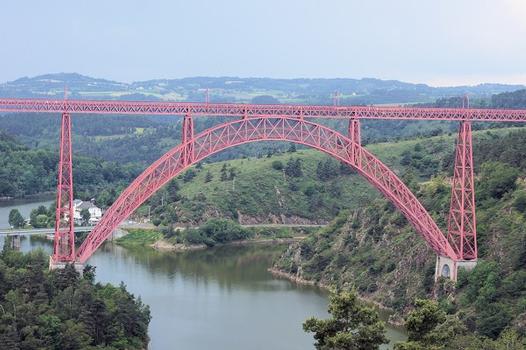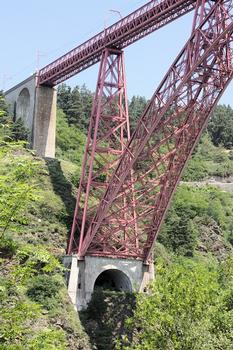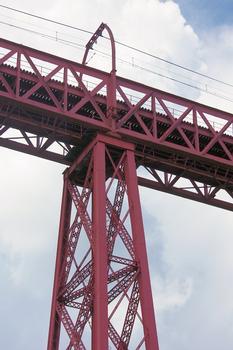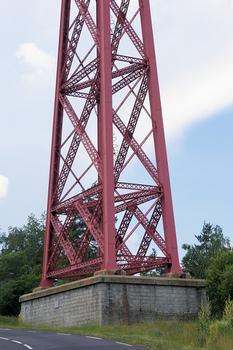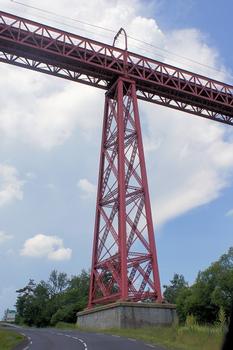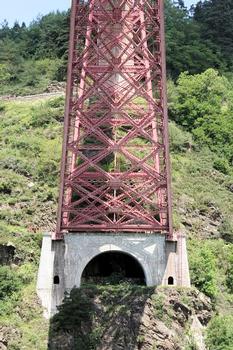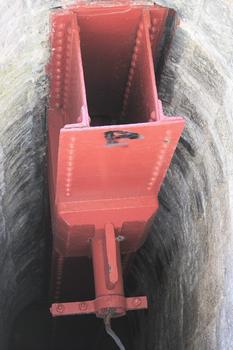General Information
| Name in local language: | Viaduc de Garabit |
|---|---|
| Beginning of works: | 1881 |
| Completion: | 17 September 1884 |
| Status: | in use |
Project Type
| Structure: |
Two-hinged arch bridge Truss arch bridge Deck arch bridge |
|---|---|
| Support conditions: |
for registered users |
| Function / usage: |
Railroad (railway) bridge |
| Material: |
Iron bridge Structurae Plus/Pro - Subscribe Now! |
Awards and Distinctions
| 1965 |
for registered users |
|---|
Location
| Location: |
Loubaresse, Cantal (15), Auvergne-Rhône-Alpes, France Ruynes-en-Margeride, Cantal (15), Auvergne-Rhône-Alpes, France |
|---|---|
| Crosses: |
|
| Part of: |
|
| Next to: |
Garabit Bridge
|
| Near: |
Bridge over the Truyere at Garabit (1993)
|
| Coordinates: | 44° 58' 32" N 3° 10' 38" E |
Technical Information
Dimensions
| main span | 165 m | |
| rise | 52 m | |
| height | 122 m | |
| total length | 564.69 m | |
| weight | 3 249 t | |
| pier height | max. 80 m | |
| northern approach viaduct | total length | 45.91 m |
| southern approach viaduct | length | 70.09 m |
| main bridge | ||
|---|---|---|
| length | 447.82 m | |
Quantities
| volume of masonry | 18 647 m³ | |
| weight of metal used | 3 326.414 t |
Materials
| piers |
wrought iron
|
|---|---|
| arch |
wrought iron
|
| truss |
wrought iron
|
Chronology
| 14 June 1879 | The project receives approval. |
|---|---|
| 26 April 1884 | Arch is joined. |
|
9 August 1888
— 13 August 1888 |
Load tests. |
Excerpt from Wikipedia
Garabit ViaductCoordinates44°58′31″N 3°10′39″E / 44.97528°N 3.17750°E / 44.97528; 3.17750CarriesrailwayCrossesriver TruyèreCharacteristicsMaterialWrought ironTotal length565 m (1,854 ft)Longest span165 m (541 ft)HistoryArchitectGustave EiffelConstruction start1882Construction end1884Construction cost3,100,000 francs
The Garabit Viaduct (Viaduc de Garabit in French) is a railway arch bridge spanning the Truyère, near Ruynes-en-Margeride, Cantal, France, in the mountainous Massif Central region.
The bridge was constructed between 1882 and 1884 by Gustave Eiffel, with structural engineering by Maurice Koechlin, and was opened in 1885. It is 565 m (1,854 ft) in length and has a principal arch of 165 m (541 ft) span.
Background
By the late 1870s, Eiffel & Cie, the company founded by Eiffel in partnership with Théophile Seyrig, had established a place among the leading French engineering companies. Between 1875 and 1877, the company had built the Maria Pia Bridge over the Douro at Porto, and when the construction of a railway between Marvejols and Neussargues, both in Cantal, was proposed, the work of constructing a viaduct to cross the Truyère was given to Eiffel without the usual process of competitive tendering. That was at the recommendation of the state engineers since the technical problems involved were similar to those of the Maria Pia Bridge. Indeed, it was Eiffel & Cie's success with that project that had led to the proposal for a viaduct at Garabit.
Design and construction
Opening with a single track in November 1885, the Garabit Viaduct was 565 m (1,854 ft) long and weighed 3,587 tonnes (3,530 long tons; 3,954 short tons). Even more impressively, the actual deflection (load displacement) was measured at 8 millimetres (0.315 in), just what had been calculated by Eiffel. At 124 m (407 ft) above the river, the bridge was the world's highest when it was built. The overall project cost was 3,100,000 francs.
Until 11 September 2009, one regular passenger train each way passed daily over the viaduct: a Corail route from Clermont-Ferrand to Béziers. On that date, the viaduct closed after cracks were discovered in one of the foundation piles. After a safety inspection, the Garabit viaduct reopened the next month, with a speed limit of 10 km/h (6 mph) for all traffic.
Text imported from Wikipedia article "Garabit viaduct" and modified on 22 July 2019 under the CC-BY-SA 3.0 license.
Participants
-
Compagnie des établissements Eiffel
- Maurice Koechlin (designer)
- Léon Boyer (designer)
- Gustave Eiffel (designer)
Relevant Web Sites
Relevant Publications
- (1986): L'architecture du fer. France: XIXe siècle. Editions Champ Vallon, Seyssel (France), ISBN 9782903528713, pp. 110-111.
- (1997): L'architecture et les ingénieurs. Deux siècles de réalisations. Moniteur, Paris (France), pp. 103.
- (1997): L'art de l'ingénieur. constructeur, entrepeneur, inventeur. Éditions du Centre Georges Pompidou, Paris (France), pp. 203-204.
- (1997): Bridges. A history of the world's most famous and important spans. Black Dog & Leventhal, New York (USA), pp. 56-57.
- (2017): Bridges. A History of the World's Most Spectacular Spans. 2nd edition, Black Dog & Leventhal, New York (USA), ISBN 978-0316507943, pp. 58-59.
- About this
data sheet - Structure-ID
20000027 - Published on:
28/10/1998 - Last updated on:
05/02/2016

